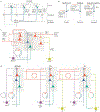Untangling the cortico-thalamo-cortical loop: cellular pieces of a knotty circuit puzzle
- PMID: 33958775
- PMCID: PMC9006917
- DOI: 10.1038/s41583-021-00459-3
Untangling the cortico-thalamo-cortical loop: cellular pieces of a knotty circuit puzzle
Abstract
Functions of the neocortex depend on its bidirectional communication with the thalamus, via cortico-thalamo-cortical (CTC) loops. Recent work dissecting the synaptic connectivity in these loops is generating a clearer picture of their cellular organization. Here, we review findings across sensory, motor and cognitive areas, focusing on patterns of cell type-specific synaptic connections between the major types of cortical and thalamic neurons. We outline simple and complex CTC loops, and note features of these loops that appear to be general versus specialized. CTC loops are tightly interlinked with local cortical and corticocortical (CC) circuits, forming extended chains of loops that are probably critical for communication across hierarchically organized cerebral networks. Such CTC-CC loop chains appear to constitute a modular unit of organization, serving as scaffolding for area-specific structural and functional modifications. Inhibitory neurons and circuits are embedded throughout CTC loops, shaping the flow of excitation. We consider recent findings in the context of established CTC and CC circuit models, and highlight current efforts to pinpoint cell type-specific mechanisms in CTC loops involved in consciousness and perception. As pieces of the connectivity puzzle fall increasingly into place, this knowledge can guide further efforts to understand structure-function relationships in CTC loops.
Figures







Similar articles
-
Anterolateral Motor Cortex Connects with a Medial Subdivision of Ventromedial Thalamus through Cell Type-Specific Circuits, Forming an Excitatory Thalamo-Cortico-Thalamic Loop via Layer 1 Apical Tuft Dendrites of Layer 5B Pyramidal Tract Type Neurons.J Neurosci. 2018 Oct 10;38(41):8787-8797. doi: 10.1523/JNEUROSCI.1333-18.2018. Epub 2018 Aug 24. J Neurosci. 2018. PMID: 30143573 Free PMC article.
-
Cortico-Thalamo-Cortical Circuits of Mouse Forelimb S1 Are Organized Primarily as Recurrent Loops.J Neurosci. 2020 Apr 1;40(14):2849-2858. doi: 10.1523/JNEUROSCI.2277-19.2020. Epub 2020 Feb 19. J Neurosci. 2020. PMID: 32075900 Free PMC article.
-
Morphological Characterization of a Cortico-cortical relay in the cat sensorimotor cortex.Cereb Cortex. 1997 Mar;7(2):100-9. doi: 10.1093/cercor/7.2.100. Cereb Cortex. 1997. PMID: 9087819
-
Unveiling the diversity of thalamocortical neuron subtypes.Eur J Neurosci. 2012 May;35(10):1524-32. doi: 10.1111/j.1460-9568.2012.08033.x. Eur J Neurosci. 2012. PMID: 22606998 Review.
-
Cortico-thalamic interplay and the security of operation of neural assemblies and temporal chains in the cerebral cortex.Biol Cybern. 1996 Sep;75(3):263-75. doi: 10.1007/s004220050293. Biol Cybern. 1996. PMID: 8900040 Review.
Cited by
-
Inhibitory synaptic loss drives network changes in multiple sclerosis: An ex vivo to in silico translational study.Mult Scler. 2022 Nov;28(13):2010-2019. doi: 10.1177/13524585221125381. Epub 2022 Oct 3. Mult Scler. 2022. PMID: 36189828 Free PMC article.
-
Cortical glutamatergic projection neuron types contribute to distinct functional subnetworks.Nat Neurosci. 2023 Mar;26(3):481-494. doi: 10.1038/s41593-022-01244-w. Epub 2023 Jan 23. Nat Neurosci. 2023. PMID: 36690901 Free PMC article.
-
Endocannabinoid signaling regulates post-operative delirium through glutamatergic mediodorsal thalamus-prelimbic prefrontal cortical projection.Front Aging Neurosci. 2022 Dec 1;14:1036428. doi: 10.3389/fnagi.2022.1036428. eCollection 2022. Front Aging Neurosci. 2022. PMID: 36533179 Free PMC article.
-
Apical amplification-a cellular mechanism of conscious perception?Neurosci Conscious. 2021 Oct 13;2021(2):niab036. doi: 10.1093/nc/niab036. eCollection 2021. Neurosci Conscious. 2021. PMID: 34650815 Free PMC article.
-
A Case for Thalamic Mechanisms of Schizophrenia: Perspective From Modeling 22q11.2 Deletion Syndrome.Front Neural Circuits. 2021 Dec 8;15:769969. doi: 10.3389/fncir.2021.769969. eCollection 2021. Front Neural Circuits. 2021. PMID: 34955759 Free PMC article. Review.
References
-
- Jones EG The Thalamus. 2 edn, (Cambridge University Press, 2007).
-
- Llinás R, Urbano FJ, Leznik E, Ramirez RR & van Marle HJ Rhythmic and dysrhythmic thalamocortical dynamics: GABA systems and the edge effect. Trends Neurosci 28, 325–333 (2005). - PubMed
-
-
Halassa MM & Acsády L Thalamic inhibition: diverse sources, diverse scales. Trends Neurosci 39, 680–693 (2016).
This review highlights how thalamic function is influenced by inhibition from the TRN and extrathalamic sources such the basal ganglia.
-
Publication types
MeSH terms
Grants and funding
LinkOut - more resources
Full Text Sources
Other Literature Sources
Research Materials

